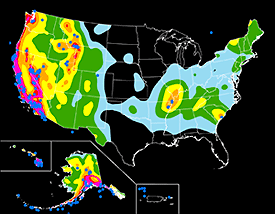
Preparing for a DisasterThere are severeral significant emergencies that could befall the Lomita community: fire, chemical spill, terrorism, but the most frightening and immediate emergency is likely to come from earthquakes. This page talks about earthquakes and preparation for the disruption that would be caused by a major seismic event. Issues relating to terrorism are elaborated on the "Terrorism" page, linked above and here. Earthquake Threat
This map shows relative earthquake shaking hazards in the United States and Puerto Rico. During a 50-year time period, the probability of strong shaking increases from very low (white), to moderate (blue, green, and yellow), to high (orange, pink, and red). It is clear that we are in one of the more vulnerable areas. Map source: USGS A sobering simulation of the effects of a magnitude 7.8 earthquake on the Los Angeles area can be seen in the following link. Although the full extent of the damage of such a quake cannot be predicted with total accuracy, it is safe to say that there will be major disruption to communication and transportation. Furthermore the first responders: fire, police and medical will be stretched to the limit and possibly incapacitated themselves. Recent estimates have indicated that after a major earthquake, communities in Southern California will have to depend on their own resources for at least 3 days and possibly as much as 2 weeks. Part of the CERT Training course covers the basics of preparedness. Community Based PreparednessCommunity-based preparedness planning allows us to prepare for and respond to anticipated disruptions and potential hazards following a disaster. As individuals, we can prepare our homes and families to cope during that critical period. Through pre-event planning, neighborhoods and worksites can also work together to help reduce injuries, loss of lives, and property damage. Neighborhood preparedness will enhance the ability of individuals and neighborhoods to reduce their emergency needs and to manage their existing resources until professional assistance becomes available. Studies of behavior following disasters have shown that groups working together in the disaster period perform more effectively if there has been prior planning for disaster response. These studies show that organized grassroots efforts may be more successful if they are woven into the social and political fabric of the community-neighborhood associations, schools, workplaces, places of worship, and other existing organizations. Effective response therefore requires comprehensive planning and coordination of all who will be involved-government, volunteer groups, private businesses, schools, and community organizations. With training and information, individuals and community groups can be prepared to serve as a crucial resource capable of performing many of the emergency functions needed in the immediate post-disaster period. The Community Emergency Response Team (CERT) program is designed to help communities prepare for effective disaster response through training and planning. Personal PreparednessIf you have not already done so, now would be a very good time to prepare yourself and your family for any major emergency. You should truly consider being able to be self-sustaining for at least 72-hours. Some things that you need to consider keeping in your emergency kit are:
To help yourself and the community take a few minutes to complete the survey linked here. If you have any relevant useful skills or equipment please send a copy of your survey to Lomita CERT as indicated at the Contact Us page. If you are a licensed amateur radio operator (Ham) who desires to serve the community, the ham radio will back up the Fire Department's 800-MHz radio system and provide radio support to CERT members, their families, and their Battalion Coordinators, please contact Lomita CERT or the Los Angeles County Fire Department directly.
TEST
|

 Earthquakes can happen anywhere,
but our area is especially susceptible
and unique. Check out the map on the right.
Earthquakes can happen anywhere,
but our area is especially susceptible
and unique. Check out the map on the right.